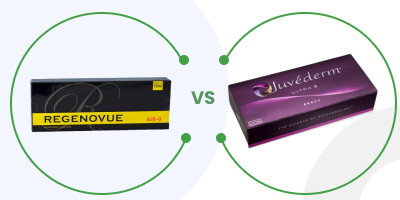
Regenovue is one of several emerging Korean filler brands that have been developed to address a range of treatment areas, from facial contouring to lip augmentation. Although relatively new on the global market, it has made waves due to its cost-effective pricing and promising natural looking results. Like most hyaluronic fillers, Regenovue relies on hyaluronic acid to add more volume and enhance the overall appearance of the face.
Juvederm, on the other hand, is a well-known name, easily accessible through authorized clinics. Manufactured by a company with a longstanding reputation in aesthetic medicine, Juvederm’s product line features different formulas designed to address numerous areas and concerns. Whether it’s smoothing out fine lines or improving lip lines, Juvederm has a hyaluronic based approach that doctors have trusted for years.
Both Regenovue and Juvederm contain hyaluronic acid HA, which is beneficial for skin hydration. These dermal filler treatments aim for natural looking improvements, while offering patients long-lasting results with minimal time of recovery.
Both Regenovue and Juvederm utilize hyaluronic acid to help retain moisture in the facial skin. The key difference often lies in their proprietary technologies for stabilizing the substance:
Although both are considered hyaluronic acid HA fillers, their performance can vary slightly based on how they were produced.
One notable term often discussed is cross-linked hyaluronic acid, which refers to the chemical process that makes hyaluronic acid chains more resistant to degradation. By prolonging the substance’s breakdown, fillers can remain effective for an extended period. Regenovue and Juvederm both employ cross-linking, ensuring that they offer a stable, natural looking volumizing effect.
Another factor is whether the products contain lidocaine. Juvederm, for example, includes lidocaine in most of its formulas to reduce discomfort. Regenovue also offers versions formulated with lidocaine, helping patients experience a smoother treatment session.
Both Regenovue and Juvederm are dermal filler options designed for non-surgical enhancement of facial volume. They can be used to treat wrinkles, address nasolabial folds, and perform facial contouring in different facial areas. Here are a few key points:
Juvederm has a variety of specialized formulations targeting areas of the face such as cheeks, lips, and under-eye hollows. Regenovue, while offering fewer variants, covers a broad spectrum of treatment indications. Both aim to provide natural looking outcomes by restoring the volume and stimulating some level of collagen production, contributing to firmer, youthful skin.
A dermal filler is generally considered safe if used correctly. Nevertheless, minor side effects may occur, including redness, swelling, or bruising. Although such reactions are usually mild, some individuals might experience allergic reactions.
Juvederm is FDA approved, which means it has gone through stringent clinical assessments. Regenovue, as one of the newer filler brands, is also subjected to quality standards, although different regions have different regulations. Regardless of the brand, a prudent approach and professional expertise ensure the best course of action for each patient’s skin types and desired outcome.
One advantage of Regenovue is its cost-effective pricing. For patients looking for a high-quality dermal filler, Regenovue often presents a more budget-friendly option compared to some established brands. However, Juvederm’s proven track record and broad product line also justify its price point for many individuals. In both cases, results can last up to two years, depending on the filler type and the treatment areas.
Keep in mind that the overall cost will vary by region, practitioner expertise, and how much filler is injected. Balancing cost, efficacy, and natural looking results is crucial when making the final decision.
For patients comparing different options, it may also be helpful to review Stylage Filler vs. Juvederm, as both share similarities with Regenovue in terms of hyaluronic acid technology.
Whichever dermal filler you choose, correct technique and expertise are pivotal for natural looking results. Since both Regenovue and Juvederm aim to reduce wrinkles and restore volume, the ideal pick hinges on factors like personal preference, budget, and desired results. A skilled injector will assess your facial areas and determine how best to accomplish your aesthetic goals. Whether you opt for Regenovue or Juvederm, the aim is always to boost your facial appearance without looking overdone.
In many cases, practitioners may suggest a consultation to determine which filler is suitable for you. By customizing treatment approaches, you can attain natural looking benefits tailored to your face’s unique contours, ensuring that the outcome meets your desires.
Both Regenovue and Juvederm online have their advantages, from cost-effective solutions to proven dermal filler credibility. Each brand can help treat folds and wrinkles and boost volume in a non-surgical way, granting patients youthful, harmonious results. Ultimately, the choice depends on individual needs and professional guidance.